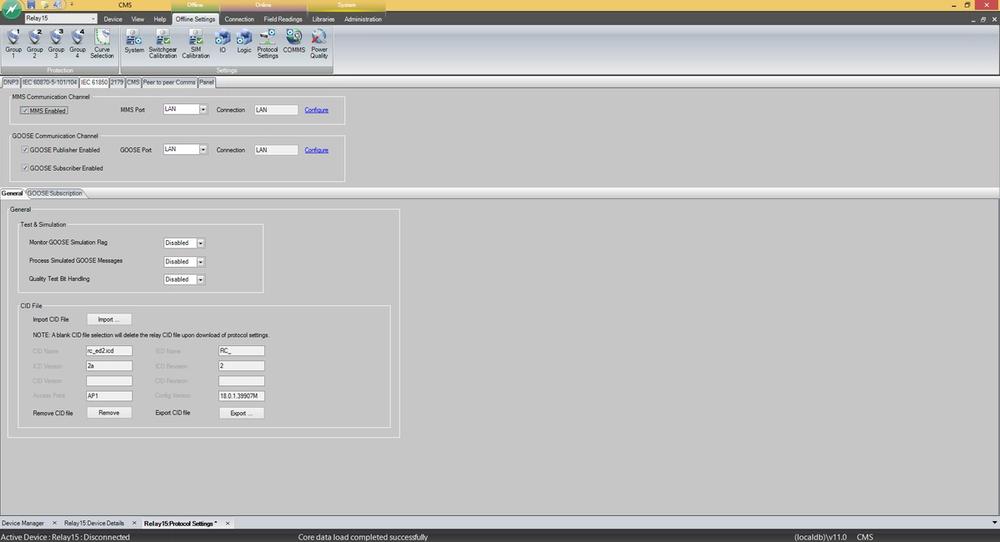Press Release
Published 11/2016
NOJA Power's IEC 61850 Implementation is intuitive, versatile and ready to use
NOJA Power in its release of Relay Firmware 1.15.0.0 and CMS 3.1 includes the recognized protocol IEC 61850.

In response to fulfil part of NOJA Power’s mission to offer its customers integrated solutions using innovative products, NOJA Power has incorporated IEC 61850 to its Recloser Controller (RC).
IEC 61850, the standard protocol for power utility automation has been approved to be utilized for Smart Grid solutions. It includes features that other protocols do not support, such as interoperability amongst Intelligent Electronic Devices (IEDs) from different manufactures, self-describing components and using well-known protocols in the industry, like Manufacturing Message Specification (MMS) and Ethernet to increase the speed requirements to safeguard the electrical system. These characteristics of the IEC 61850 are acknowledged by power utility engineers as essential for effective smart grid applications. The important or interesting factor is how these features are applied to a device so that it is innovative and contemporary at the same time. The following will depict some of those features that engineers at NOJA Power have made possible.
Simple and intuitive interface (IEC 61850 model)
NOJA Power applies the IEC 61850 model using Logical Device (LD) names to implement the functionalities of Automatic Circuit Reclosers (ACR or “auto-recloser”)
One of the characteristics of IEC 61850 is the ability to provide abstract information modelling methods for logical devices (LD), logical nodes (LN), data, and data attributes (DA). Beginning with logical devices, each LD is an entity that represents a set of typical automation, protection or other functions. The LDs facilitate the grouping of logical nodes according to their functionalities within IEC 61850 model. NOJA Power has implemented 10 LDs, as shown in the following picture. For instance, the Earth Fault Logical Device (EFLD) has different kinds of Logical Nodes (LN) internally, such as LPHD and LLN0 which provide description and handling, overcurrent protection LNs (PTOCs) e.g. Earth fault has 6 PTOCs [EF1+, EF2+, EF3+, EF1-, EF2-, EF3-], one Directional Element (RDIR) and one Protection Trip Conditioning (PTRC). Every Logical Node is made up of data and data attributes which define its functionalities, all of them are in accordance with the first edition of IEC 61850.

Versatility (Communication through different ports, Interoperability and Access to multiple clients)
Taking advantage of the characteristics of the NOJA Power recloser to make it a versatile implementation of IEC 61850
Versatility is not a specific characteristic of IEC 61850, but is dependent on how it has been applied to a device. Therefore, it relies on the features of the NOJA Power recloser and how IEC 61850 has been implemented. It is safe to say that NOJA Power’s IEC 61850 device can be considered as a versatile IEC 61850 device. One example is the implementation of the MMS and GOOSE (Generic Object Orient Substation Event) protocols as they can be handled either over one port or using two ports of communication. This means that the device can use one port for GOOSE messages, while another can be used by a SCADA protocol such as DNP 3.0, IEC 60870-5-101/104 or IEC 61850. These kind of configurations help separate traffic going into a substation to be used as required.
Another important factor is that NOJA Power’s recloser can be used by an already running IEC 61850 project and it will communicate with devices from first and second edition from different manufacturers without any struggle if they meet the protocol requirements. This concept is known as interoperability and it is completely fulfilled by the NOJA Power IED.SCADA communication using IEC 61850 is through the MMS protocol. This protocol can communicate with up to four clients simultaneously. This versatile characteristic is also supported by the index function in the Report Control Block (RCB) which means that one IED can make multiple instances of a report control class with all instances available and visible to all clients.

Ease to use (ICS, Direct subscription)
With a few clicks and filling in some fields you can have an IEC 61850 file.
NOJA Power provides a dedicated tool, the “IED Configurator Software” which expedites the configuration of the IED Capability Description (ICD) to create a Configured IED Description (CID) file, this useful tool is available to our registered customers at no charge. Open an ICD file, create a new Dataset, select the desired data and then associate these with Report or GOOSE Control Blocks. With just a few simple steps a CID file can be created easily and can be ready to send to the relay through CMS.
When utilities talk about subscription, they normally use intermediate variables which work as wildcards. These are used for logic or to transfer the values to other variables. In the case of CMS, however, it is much easier: the subscribed data attribute is linked to its target data directly without any use of intermediate variables. That means short operating times and the subscription’s purpose is easier to understand. Moreover, the subscribed data attributes can be directly used in SGA “Smart Grid Automation”. This is of great benefit as it helps to take advantage of the whole potential that IEC 61850 and IEC 61499 have.

“In order to ensure our customers the maximum interoperability, it was important to implement a flexible version of IEC 61850,” says NOJA Power Group Managing Director Neil O’Sullivan. “Our customers are not only using IEC 61850 in substation applications they are also using the GOOSE messaging component together with the DNP3 protocol to provide a complete automation solution.”
NOJA Power is continuously improving the IEC 61850 implementation to meet the challenges proposed by our customers and to incorporate any enhancements in the standard. Our engineers are therefore striving to maintain an intuitive, versatile and friendly IEC 61850 application.
Reference
1. Part 7-2: Basic information and communication structure – Abstract communication service interface (ACSI). (2010). IEC.
Want to stay up to date with Electrical Distribution Technology?
Join our list for a free weekly technical bulletin, as we share our Global Electrical Engineering experience directly to your inbox.
Subscribe →